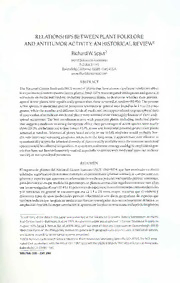
RELATIONSHIPS BETWEEN PLANT FOLKLORE AND ANTITUMOR ACTIVITY: AN HISTORICAL REVIEW PDF
Preview RELATIONSHIPS BETWEEN PLANT FOLKLORE AND ANTITUMOR ACTIVITY: AN HISTORICAL REVIEW
RELATIONSHIPSBETWEENPLANTFOLKLORE ANDANTITUMORACTIVITY:ANHISTORICALREVIEW^ RichardW.Spjut^ WorldBotanicalAssociates P.O.Box81145 Bakersfield,California93380-1145,U.S.A. www.Worldbotanical.com ABSTRACT iTnheexNpaetriiomneanltaClantcuemrorInsstyisttuteem'ss((aNcCtIi)verpelcaonrtds)t,:>l1p9l6a0n-t1s97th4a,twhaasvecosmhpoawrnedsiwginitfhicsapnetciienshaibnidtogreyneerfafemct referencesonmedicinalfolklore,includingpoisonousplants,todeterminewhethertheirpercent- agesofactiveplantsweresignificantlygreaterthanthosescreenedatrandom(10.4%).Thepercent activespeciesinmedicinaland/orpoisonousreferencesingeneralwereioundtobe1.4to2.6times greater,whilethenumberanddifferentkindsofmedicinalusesappearrelatedtogeographicaldata ofspeciesthatalsoindicatemedicinalplantswerescreenedmorethoroughlybecauseottheirwide- spreadoccurrence.Thebestcorrelationisseenwithpoisonousplants,includingmedicinalplants thatsuggestamoderatetostrongtherapeuticeffect;theirpercentagesoiactivespecieswerenearly three(29.3%,anthelmintics)tolourtimes(4.5.7%,arrowandhomicidalpoisons)greaterthanplants screenedatrandom.Selectionofplantsbasedstrictlyonuseinfolkmedicinewouldprobablyben- efitnew(start-up)screeningprograms,whereasinthelong-term,itappearsmorecosteffectiveto systematicallyscreenthebroadestdiversityofplantsreadilyavailablesincethecommonmedicinal specieswouldbecollectedirregardless.Asystematiccollectionstrategycouldgiveemphasistogen- erathathavenotbeenexhaustivelystudied,especiallytospecieswithruedicinalusesthatindicate toxicityorareconsideredpoisonous. RESUMEN ElregistrodeplantasdelNationalCancerhistitute(NCI)1960-1974,quehanmostradounefecto inhibidorsignificativoensistemastumoralesexperimentales(plantasactivas),secompararoncon generosyespeciesqueaparecenenreferenciasdemedicinapopular,incluyendoplantasvenenosas, paradeterminarenquemedidalosporcentajesdeplantasactivaseransignificativamentemasaltas quelasinvestigadasalazar(10.4%).Elporcentajedeespeciesactivasrelerenciadascomomedicinales y/ovenenosasengeneralseencontroqueerade1.4a2.6vecesmayor,mientrasqueelnumeroy diferentestiposdeusosmedicinalesparecenrelacionadoscondatosgeograficosdeespeciesque tambienindicanquelasplantasmedicinalesiueroninvestigadasmasminuciosamentedebidoasu ampliadistribucion.Lamejorcorrelacionseapreciaconlasplantasvenenosas,incluyendolasplantas 'AsummaryofthedatainthispaperwaspresentedattheSocietyforEconomicBotanySymposiumonPlants AndCancerheldinBaltimore,August1975.AnalternatepaperwaspublishedInCancerTreatmentReportsin August1976(Spjut&Perdue.Vol.50,8:979-985).LeftoutwerealldataanddiscussiononQuisumbing's(1951) MedicinalPlantsofThePhilippines,reviewsongenerawithgeographicallydisjunctusesofmedicinalspecies, andactivityaccordingtothetumorsystemsemployed. ^USDAAgriculturalResearchService,MedicinalPlantResourcesLaboratory,Beltsville,MD20705.TheNCItermi- natedtheiragreementwiththeARSinOct1982,SpjutlefttheUSDAinMarch1997.WorldBotanicalAssociates, Bakersfield.CA93380-1145. SIDA21(4):2205-2241.2005 2206 BRIT.ORG/SIDA21(4) medicinalesqueparecentenerunelectotcrapeuticodemoderadoaluerte;losporcentajesdeespecies activastuedccercadetres(293%,antihelminticos)acuatroveces(45.7%.venenosparaIlechasy homicidios)nnu'ort[uclasplanusmvcstigadasalazar.Laselecciondeplantasbasadaestrictamente enelusoenmedicinapopulai'probablcmentcsenabencliciosaparalosnuevosprogramasde investigacion,inientrasquealargocermmo,pareceteneruncostoelectivomayorlainvestigacion sistematicadeunadiversidaddcplantasfacilmentedisponiblesyaquelasespeciesmedicinales comunespuedcncolcctarseencualquierparte.Unaestratcgiadecolectasistematicapondriacnlasis engencrosi.|uenohayansideestudiadose.Khaustivamentc,yesiiecialmcnteenespeciesconusos medicinalest|ucindic|uentoxicidadoqueseconsidercnvencnosas. INTRODUCTION TheUSDAAgriculturalResearchService(Ai^S)wasamajorsuppHcrofplant sampleslortheNationalCancerInstitute(NCI)CancerChemotherapyScreen- ingProgramfrom1960-1982.Theobjectiveofthisprogramwastoidentifynovel chemicalstructuresproducedbyplantsthatwouldbeusefulintreatmentof cancerTwomajordiscoverieso(novelanticancerdrugsfromthisperiodwere taxol(Wanietal.1971),isolatedfroinstem-barkof TaxushreviJoUaNutt. (Taxaceae),mitiallycollectedinWashington,August1962,followeddiscovery ofconfirmedantitumoractivityinKBCellCulture(KB),July1964(NCICPAM, 1977), and camptothecin(Wallet al. 1966), isolated from Camptotheca acuminaUiDecne.(Nyssaceae),basedonfruitsamplescollectedmSeptember 1961tromaUSDAPlantIntroductionStationinChico,California,andreported tohaveconfirmedantitumoractivityinL-1210Leukemia(LE),July1962(NCI CPAM1977).Semi-syntheticderivativesofcompoundsfrombothspeciesare currentlyemployedtotreatvariouscancers(Craggetal.1996).Thecommer- cialdevelopmentoftheseanticancerdrugs,however,didnotoccuruntilthe 1990s.In1986,theNCIre-developeditsbiodiversityscreeningprogramofnatu- ralproducts(Boyd1992;Craggetal.1996;Newmanetal.2003);however,the acquisitionofplantsamplesfortheNCIscreenwassuspendedin2004. InAugust197.5,asymposiumon"PlantsandCancer"washeldinBalti- more,MDattheAnnualMeetingoftheSocietyforEconomicBotany.Thecon- tributorsincludedmanyscientistsactivelyinvolvedintheNCIsearchofnew anticancerdrugsfromplantproductswhohadagreed,inadvance,toprovid- ingaresearchcontribution.Myassignedstudywas"PlantFolklore:AToolfor PredictingSourcesofAntitumorActivity?Othercontributedpaperswere"Pro- curementofPlantMaterialsforAntitumorScreening"(Perdue1976),"Prepara- tionofPlantExtractsforAntitumorScreening"(Statz&Coon1976),"Bioassay ofPlantExtractsforAnticancerActivity"(Abbott1976),"IsolationandChemi- calCharacterizationofAntitumorAgentsfromPlants"(Walletal.1976),"Types ofAnticancerAgentsIsolatedfromPlants"(Hartwell1976),"Distributionof AnticancerActivityin1ligherPlants"(Barclay&Perdue1976),"NovelPlant- DerivedTumorInhibitorsandTheirMechanismsofAction"(Kupchan1976), "PharmacologyofAntitumorAgentsfromHigherPlants"(Siebcretal.1976), SPJUT,HISTORICALREVIEWOFPLANTFOLKLOREANDANTITUMORACTIVITY 2207 and"PlantProductsinCancerChemotherapy"(Carter1976).Theseandothers werepublishedcollectivelyinCancerTreatmentReports,editedbyRobertE. PerdueJr,andJonathanL.Hartwell(Vol.60,No.8,1976). Uponinvestigatingtherelationshipsbetweenantitumoractivityandplant folklore,Ifeltthatplantsusedinfolklorewerenotgoingtoleadtodiscoveryof novelcompoundsanymorethanasystematicsamplingoftheworldsplant diversitybasedontaxonomy,theapproachthathadbeeninpractice14years. Therefore,inordertoshowthis,themostcommonmedicinalusesofplants, andalsopoisonousplants,wouldneedtobemvestigated.Duringthecourseof thestudy,theresultsontheNCIactivespeciesfoundinliteratureonmedicinal andpoisonousplants,incomparisonstothosescreenedatrandom,raisedmore questionsthancouldbeanswered,includingtheoneoriginallyproposed.The SpjutandPerdue(1976)paperexcludedmuchdatainanothermanuscriptthat hadbeencompletedandpeerreviewed. Afternearly30years,theunpublisheddatastillseemrelevanttopresent daystudiesinethnobotanyandpharmacology,particularlytherelationship betweenantitumoractivityandfolkloreindicatmgplanttoxicity;therefore,this paperwillfocusonthatrelationship,includingalsodatafromSpjutandPer- due(1976).Anotherimportantrelationshipinvolvesthemultipleusesforalarge numberofwidelydistributedspecies;theirimpactontheapparentcorrelation betweenantitumoractivityandmedicinalfolklorewillbediscussed.Addition- ally,Spjut(1985)reviewedtherandomscreenmethodologyindetailwithrefer- encetounpublisheddataonThePhilippinemedicinalplants;thesedatawill bepresentedinthispublication. MATEI^IALSANDMETHODS — LiteratureSurveys. Thispaperdealswithdatacompiledfromliteratureand theNCIplantscreeningprogrampriorto1977.Folkloreandplantsinthisstudy werelimitedtoliterarysourcesforevaluatingmedicinalusesandpoisonous effectsofhigherplantsinmanandanimals.Includedareplantsbelievedtohave medicinalorpoisonousproperties,andthescientificliteraturedealingwith activechemicalagentsinconfirmedpoisonousandmedicinalplants.Botani- caldataandthereferencescited,includingthenomenclatureofplants,arenot updatedsincethispaperwaspreparedandlastreviewedmJuly1976;however, inregardtopharmacologicaldataoncompoundsthatwereisolated,morere- centreferencesareprovided. Eightcompendiaonmedicinalandpoisonousplantswereemployedto identifywhichoftheirgeneraandspecieswereactiveintheNCIprogram:Har- din&Arena(1974),Hartwell(1967-1971),Kingsbury(1964),Krochmal& Krochmal(1973),Quisumbing(1951),Trametal.(1957),Webb(1948),andWeiner (1972).Oneofthese,Quisumbing(1951),wasfurtherutilizedtodetermine whetheraspecificmedicinalusewasmorecloselycorrelatedwithantitumor 2208 BRIT.ORG/SIDA21(4) activity.Becauseantitumoractivityappearedtocorrelatewithawidevariety ofmedicinaluses,additionaldatafromQuisumbing(1951)werecompiledand analyzedinregardtomultipleusesof plantsasrelatedtotheirgeographical distribution.Additionallywe(Spjut&Perdue1976)preparedourowncompila- tiononplantsusedas(1)anthelmintics,(2)fishpoisons,and(3)arrow,ordealand homicidalpoisonstodeterminewhethertherewasacorrelationbetweenantitu- morAaccttiivvietyspaencidesp.l—antAntoxaicctiitvyeisnpceocnitersaisstdteofimneeddicaisnaolneplraenptrseisnengteenedrably.oneor moreextractshavingshownasigniiicantinhibitoryelfeetinanytumorsys- temusedintheNCIpreliminaryscreen;thesewereprimarilyKBCellCulture (humanepidermoidcarcinomaolthenasopharynx,KB,1960-1982),P-388Leu- kemia(PS,1968-82),LewisLungCarcinoma(LL,1962-66),WalkerCarcinoma 256(WA,1966-69),Sarcoma180(SA,1956-62),Adenocarcinoma755(CA,1956- 62)andL-1210Leukemia(LE,1956-71)(Abbott1976;Gcranetal.1972;ilartwell 1976;Suffness&Douros1979).TheNCIprovidedaprint-outoftheiractivespe- cieslorthisstudy;additionally,anotherprintoutindicatingtumorsystemsfor theconfirmedactivespecieswasconsulted(NCICPAM1977). Activeagentshaveincludedabroadspectrumof compounds(Hartwell 1976),someofwhichwereprecludedfronifurtherscreening(e.g.,tannins,phy- tostcrols)bychangesmadeintheextractionprocedureandtumorassays (Llartwell1976);thus,theNCIscreenevolvedtobecomemoreselectiveiniden- tifyingactivecandidatesfordrugdevelopmentbyeliminatingclassesofcom- poundsnotconsidered useful fortreatingcancer(Hartwell&rAbbott1969). Duringthe1960s,tannins—inaqueousextractsfromawidevarietyofplants- wereIrequentlyactiveinWA,butalsoinCA,LLandSAtumors;atotalof164 species,representing7.7%ofallactivespecies(2,127)inthisstudyweretannin actives(Barclay&Pcrduel976;Hartwell1976).Later,tanninswereextracted outbeforetesting,whiletumorsinsensitivetotanninsweresubsequentlyem- ployed(Hartwell 1976).Consequentlymanyvariablesarerepresentedinthe definitionol anactivespecies,suchasdifferencesinextractionprocedures, quantityandkindoftumorsystemsemployed,parametersthatdefineactivity fromtestingextracts,andwhetherspecilicplantpartsscreenedcorrespondto thoseemployedinfolklore.Nevertheless,itisfeltthatallplantsregardedactive l3ytheNCIfrom1960-1976arevalidformakingcomparisonswithfolkusesof plants. ComparisonsbetweentheNCIactivespeciesandthoseintheliterature consideredtaxonomicsynonymsandcloselyrelatedspecieswhenknown.For instance,theNCIactivespecies.Thaiictrumpolycarpum(Torr)S.Wats.,based onasamplecollectedandidentifiedbyAS.BarclayfromsouthernCalifornia in1962,wasnotfoundintheliteraturereviewedtohavemedicinalorpoison- ousreports;however,thisspeciescouldbeinterpretedasasynonymofT.fendlcri Engelm.(Munz1959),onethatwasreportedlyusedinmedicinebytheIndian SPJUT,HISTORICALREVIEWOFPLANTFOLKLOREANDANTITUMORAQIVITY 2209 TribesofNevada(Trametal.1957).Basedontaxonomy,I.polycarpumiscon- sideredamedicinalplant. Activegenus.Comparisonswerealsomadeatthegenuslevel;however,the sizeofthegenusvaries—fromjustonespecies(e.g.,Camptotheca)tomorethan 1,000species(e.g.,Euphorbia);Willis(1922)haddetermmedthat47%ofall generaaremonotypic,17%havetwospecies,8%havethreespecies,andthere- maining28%havefourormorespecies.Anactivegenusisonewithoneormore activespecies.Becausemostgenerahavemorethanonespecies(53%),theper- centagesofactivegenerawillbehigherthanactivespecies.Also,whenmore thanonespeciesinanactivegenusisreportedlyusedmedicinallyand/orpoi- sonous,therelationshipbetweenantitumoractivityandfolklorewillappear closer,orliebetweenthepercentagesofactivegeneraandactivespecies. RandomScreen. TherationaleoftheNCIscreenhasbeentoregardany speciesasapotentialsourcefornovelanticancerdrugs;thus,screeningofplants hasbeenconsideredrandom.Inpractice,however,collectingwasnotpurely random.Onereasonisthatitisnotpossibletocollecteveryplantspeciesen- counteredinthefield,becausethequantityofdryweightneededmaynotbe practicaltoobtain.Anotheristhatgeographicsamplinghasnotbeenunilorm forpoliticalandeconomicreasons. ThenumberofgeneraandspeciesscreenedandactiveintheNCIprogram wasdeterminedbyA.S.Barclayforthesymposiumon"PlantsandCancer"at theSocietyforEconomicBotanymeetinginBaltimore,August1975.fiisdata accountedforallspeciesandgenerascreenedbytheNCI—uptotheendol1974, takingintoconsiderationsynonymsandsamplesthattheNCIacquirednot onlyfromtheUSDA,butfromallcontractors.Histabularsummaryisrepro- ducedhere,Table1(Barclay&Perdue1976). Thepercentagesforactivegenera,26.0,andspecies,fO.4,arethebasesfor makingcomparisonstothoseinfolklorereferences;however,itmustbekeptin mindthatthenumbersforactivespeciesandgeneraarecumulative;i.e.,they donotrepresenttheactualfrequencyatwhichactivityoccurs.Thisisbecause somespecieshavebeenscreenedmorethanonce,orhaveincludedmoreplant partsthanothers,thus,havehadmoreopportunitytoshowactivity—alsokeep- ingmmindthattheNCIscreenhasbecomemoreselectiveovertime. GENHRALSURVEYS TheNCIcomputerrecordofactiveplantspecieswascomparedwithspecies andgeneracitedinindicesortextsofeightcompendiatodeterminewhich haveshownantitumoractivity(Table2).Withtwoexceptions,activespecies weref.4to2.6timesmorefrequentinreferencesonmedicinaland/orpoison- ousplantsthaninplantsscreenedatrandom,whileresultswithactivegenera weremoreconsistent—atnearlydoublethatoltherandomscreen. Thegreatervariationatthespecieslevelformedicinalplantsispartlydue 2210 BRIT.ORG/SIDA21(4) TARir1.NCIoverallscreeningdataforvascularplants(1960-1974), NumberScreened NumberActive %Active Genera 4,716 1,225 26.0 Species 20,535 2,127 10.4 tomanyspeciesnotscreened,incontrasttohigherpercentagesofgenera screened.Foronereference,Quisumbing(1951),itwasdeterminedthat626of the855speciesweretested;thus,insteadofthe16.4%activeofthoserecorded (855),22.4%ofthosespeciesactuallyscreened(626)wereactive—nearlydouble thatoitherandomscreen. Inregardtothewiderangingvaluesseenforpoisonousplants,thelower percentageol9.2%activespeciesinWebb(1948)seemsrelatedtomanyspecies thataresuspectedtocausepoisoningoflivestock.Whendatafromthesame referencewasrestrictedtospeciesthatwerereportedtobepoisonousandalso usedmedicinally,thepercentactivespecieswasnotablyhigher,18.9%.These datasuggestthatplants,bothpoisonousandusedmedicinally,aremorelikely toshowantitumoractivitythanthosestrictlyusedmedicinally.Also,datafrom otherrclerences(Kingsbury1964;Hardin&Arena1974)hadmoreplantscon- firmedtobepoisonous,whichinHardinandArena(1974)wererestrictedto thosetakeninternally(Spjut&Perdue1976).Thehigherpercentagesofactive species(21.5%,41.1%)andgenera(56.4%,66.4%)inthesereferencesonpoison- ousplantsindicatethattoxicityisafactorintheapparentcorrelationbetween antitumoractivityandplantsgenerallyusedinmedicinalfolklore. ActivePlantsAcc:ordingtoNumberandKindsofMedicinalUses Quisumbing(f951),inhisMedicinalPlantsojthePhUippincs,pro\'idedspecies indicesfor116differentcategoriesoftherapeuticusesandfor111differentkinds ofspecilicdiseases,atotalof227differentmedicinalapplicationsfromwhich 90wereselectedonthebasisof 19ormorespeciesbeinglistedtodetermine whetherantitumoractivitywasmorecloselycorrelatedwithaparticularthera- peuticeffect(Appendix1,62medicinalapplications)orspecificdisease(Ap- pendix 11,28medicinalapplications).Whatwefound,however,wasabroad correlationwithallmedicinalapplications(AppendixI,II).Thisbroadcorrela- tionappearsrelatedtoalargenumberofwidelydistributedspeciesforwhich manyhaveprobablybeenscreenedmorethanoncebytheNCI,whileacorrela- tionbetweenantitumoractivityandtoxicityisalsoevident.Theserelation- shipswillbemadeapparentinthedataanddiscussionthatfollow. Quisumbing(195f),inreportingon855speciesin580generaandf43families ofvascularplantsinThePhilippines,didnotlimithisreviewtomedicinaluses withinThePhilippines.HealsodrewonliterarysourcesoutsideThePhilippines. SPJUT,HISTORICALREVIEWOFPLANTFOLKLOREANDANTITUMORAQIVJTY 2211 Table2.Numberandpercentofactivegeneraandactivespeciesformedicinalandpoisonousplants ineightselectedreferences. Reference Genera Genera %Genera Species Species %Species Listed active active Listed active active MedicinalPlants Krochmal(1973) 207 131 63.3 251 67 26.7 Quisumbing(1951) 580 271 46.7 855 140 16.4 Trainetal.(1957) 142 77 54.2 214 32 15.0 Webb(1948) 398 228 57.3 529 87 16.5 Weiner(1972) 285 156 54.7 388 73 18.8 PoisonousPlants Hardin&Arena(1974) 113 75 66.4 141 58 41.1 Kingsbury(1964) 282 159 56.4 488 105 21.5 Webb(1948) 433 211 48.7 760 70 9.2 PoisonousPlantsusedMedicinally Webb(1948) 229 153 66.8 196 37 18.9 PlantsUsedAgainstCancer Hartwell(1967-1971) 1,201 480 46.5 2,725 314 17.3 (1,033 (tested) (1,815 (tested) tested) tested) Thus,manyplantsnotknowntobeusedmedicinallyinThePhilippineswere includedsolongastheplantoccurredthere,apracticenotuncommonlyem- ployedbymanyethnobotanistsinothergeographicstudiesofmedicinalplants. Nevertheless,theresultisthattherearemanywidespreadspeciesrepresented. ThisISevidentinpartbyfindingthat8%ofallspeciesinQuisumbing(1951) areendemictoThePhilippines,basedongeographicaldatahealsoprovided; thus,92%ofthespeciesinQuisumbing(1951)extendbeyondThePhilippines. Thedistributionofendemicspeciesaccordingtothenumberofusesis showninFigureI.Among110speciesinQuisumbing(1951)listedforonlyone medicinalapplication,25%werefoundtobeendemictoThePhilippines,fol- lowedbyasharpdeclineforthosereportedundermultipleapplications~-15% forplantslistedundertwomedicinalapplications,8%forthreemedicinalap- plication—tononefoundundernineormoremedicinalapplications.Itiscer- tainlynotsurprisingtofindthatnarrowergeographicallydistributedspecies havefewermedicinalreports. However,theextenttowhichmedicinalspeciesarereportedformanydiffer- entusesisperhapsnotfullyrealizedbymanyethnobotanists.The808specieslisted, amongthe90medicinalapplicationsselectedfromQuisumbing(1951),ac- countedforawhopping,5,843speciesentries(meaningthatmanyofthe808 speciesareusedformorethanoneapplication),thedistributionofwhichis showninFigure2.Asanaverage,50%ofthespeciesreportedunderanyone 2212 BRIT.0R6/SIDA21(4) ENDEMICSPECIESand MEDICINALAPPLICATIONS %EndemicSpecies 30- 25 20- ;"::•:•: 15 imllIii 11 10- ii 8 n-imm::i::i;,II':f:t:::::•::•::::;:::::::::m*<::-'-::;':a::;=:•:;:\:i-SS5iSS-iSiBri-Si3S:::::-; 9 10 111 1215 116- MedicinalApplications Fig.1.PercentendemicspeciestoThePhilippinesaccordingtonumberofdifferentmedicinalapplicationsbasedon90 of227medicinalapplicationsinQuisumbing(1951).Thenumberofmedicinalspeciesforeachnumberofusesisshown inFig.2.Of110speciesreportedlyusedforonlyonemedicinalapplication,25%wereendemictoThePhilippines;for specieswithtwomedicinalapplications,15%wereendemic,etc.,tonoendemicsforspeciesreportedtohavenineor moremedicinalapplications.GeographicaldataarebasedonQuisumbing(1951). medicinalapplicationwerealsofoundunder11ormoreothermedicinalappli- cations. Theextentolthewidespreadoccurrenceformanyofthemedicinalplants reportedbyQuisumbing(1951)isfurtherevidentbypercentspeciesscreened accordingtothenumberofusesrecorded.Figure3,andthefactthatrelatively fewspecieswereactuallycollectedfromThePhilippines.Someofthemedici- nalapplicationsinthehighermultipleusecategorieswerecombinedtoobtain amoreec|uitablenumberofspeciesforeachcategory.Theresultsshow,asone mightexpect,adefinitecorrelationbetweenthenumberol usesandpercent speciesscreened,increasingfrom45%forspecieswithonlyonemedicinalap- plication,to99%lorthosewith16ormoremedicinalapplications.Plantswere procuredlargelyIromtheUnitedStates,Australia,NewZealand,Fiji,Taiwan, India,Turkey,Ethiopia,Kenya,Tanzania,SouthAfrica,Ghana,Mexico,Panama, Colombia,Brazil,andPeru.Small numbersofcollectionswerealsoobtained fromothercountries;seealsoprocurementmapinPerdue(1976). Forthe90selectedmedicinalapplicationsfromQuisumbing(1851),626 speciesm531generawerefoundtohavebeenscreenedofwhich140species SPJUT,HISTORICALREVIEWOFPLANTFOLKLOREANDANTITUMORACTIVITY 2213 Species SPECIES and MEDICINAL 120 APPLICATIONS 100 80 60 40 - 20 i^^ rpfiijij^f rn 12 3 4 5 6 7 8 9 1011 1213 1415IB 171819 202122232425262728293031 MedicinalApplications Fig.2.Anumericaldistributionofspeciesaccordingtonumberofmedicinalapplicationsforatotalof90differentl(inds ofmedicinalapplicationsthatincluded808speciesinQuisumbing(1951).Thenumberofspeciesforeachnumberof medicinalapplicationsdecreasesfrom11 speciesusedforjustonepurpose,toonespecies,ArtemisiavulgarisL,cited under31differentmedicinalapplications. (22.4%)in265genera(49.7%)wereactive(AppendixIII);additionally,40%of the140activespecieswerefoundtohave12ormoremedicinalapplications. Onemedicinalapplicationwithnotablyhighpercentagesofactivespeciesand generawasplantsusedagainsthemorrhoids,.35.3%(24)ofthe68speciesand 72.1%ofthe61genera. Areplantsusedfortreatmentofhemorrhoidsmorecloselycorrelatedwith antitumoractiveplantsthanplantsusedforotherpurposes?Statistically,the distributionofactivegeneraandspeciesforthemedicinalapplicationsin Quisumbing(1951)mightbeexpectedtofollowabell-shapedcurvedistributionin whichtherewillbehigherthanaverageaswellaslowerthanaveragepercentages ofactivespecies(andgenera).Thecategorieswithhigherpercentagesofactive specieswouldalsobeexpectedtohavemorewidelydistributedspeciesbasedon datapresentedinFigures1-3andtheabsenceofplantcollectionsfromThePhilip- pinesasalreadyindicated.Indeed,among68specieslistedbyQuisumbing(1951) forplantsusedagainsthemorrhoids,75%(51)werereportedfor11ormoreother medicinalapplications,whichincluded23ofthe24activespecies.Therefore,it cannotbeconcludedthatplantsusedforaparticularremedysuchashemorrhoids aremoreHkelytoshowantitumoractivitythanplantsusedforotherpurposes. 2214 BRIT.ORG/SIDA21(4) SPECIESTESTED and MEDICINALAPPLICATIONS %SpeciesTested 123456789 10 11 12-15 16+ MedicinalApplications Fig.3.PercentofspeciesscreenedbytheNCIforantitumoractivityaccordingtonumberofmedicinalapplicationsfor 808specieslistedin90of227differentmedicinalapplicationsbyQuisumbing(1951).Thepercentscreenedforeach numericalcategoryofmedicinalusesofplantsisshowntoincreasefrom45%forspeciesreportedtohavejustone medicinaluseto99%screenedforthosereportedfor16ormoredifferentmedicinalapplications. Ontheotherhand,onemightarguethattheuseofplantsformanymedicinal remediesbyoneormorecukuresshouldconstitutestrongevidencefordiscover- ingbiologicalactivityAtthespecieslevel,however,culturaldiffusionmightex- aggerateandmultiplyreports(Watson1983),whereasmedicinalreportsbased ondisjunctoccurrencesofcloselyrelatedspeciesingeneramayappearmorevalid, depending,however,onthesizeofthegenusandnumberofmedicinalspecies reported.Thefollowingsixcasesexemplifyhowfolkloremayappearmonecase tohavestrongvaliditywhileinotherinstancesappearsinconclusive. 1)Brucea(Simaroubaceae)isasmallpaleotropicalgenusof6specieswith B.antidyscntericainAfricaandB.javanica(L.)Merr.insoutheastAsiathathave reportedlybeenusedlortreatingskindiseases,dysenterytapeworm,and cancer(Burkhill1935;Chopraetal.1956;Dalziel 1937;Hartwell1967-1971; Quisumbing1951;Watt&Breyer-Brandwijk1962;Webb1948).Anticancerac- tivityhasbeenidentifiedinbothspeciesandoneother,B.guineensisG.Don, foundonlyinwesttropicalAfricawithoutanyreporteduse.Theanticancer compound,bruceantin(Kupchanetal.1973),isolatedfromB.anlidysenterica, hasundergonepreclinicalstudiesasapotentialdrugforcancerchemotherapy. Itwastoundtobetoxicinhumanapplication;however,derivativesofrelated
